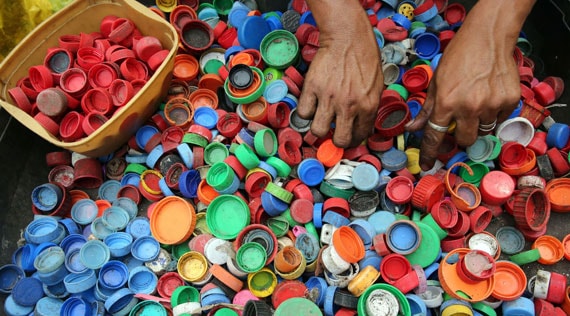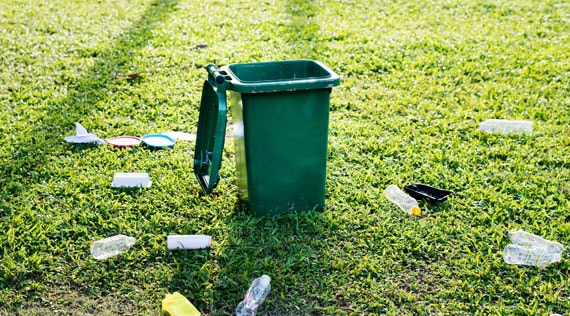RecyclingMonster - Utah has a recycling problem: we're not very good at it.
That was easy to see while walking among the crowded conveyor belts and mountains of trash on a recent tour of the Waste Management Material Recovery Facility (MRF) in West Jordan.
As Roger Horne, the facility’s supervisor, pulled a pair of pink, plastic fairy wings from a discard pile, he listed off some of the junk mistaken for recyclables.
“We’ve had water heaters. We’ve had lawn mowers, desks, file cabinets,” he said. “There’s no recyclable fairy wings.”
Horne’s facility, which receives waste from cities across the Wasatch Front, has to toss about a quarter of the material it receives because it’s contaminated — either recyclable material that hasn’t been cleaned or material that was never recyclable to begin with.
And while the list of material that can be recycled through curbside bins hasn’t changed much over the years, shifts in the global recycling market are causing a problem for some cities in Utah. They’re having to deal with rising costs and cut back on what residents can throw in their bins.
Utah isn’t the only state that’s not great at recycling. Contamination rates here are consistent with nationwide estimates, but it hasn’t always been this way.
Dan Cotter, a San Francisco-based scrap trader who does business in Utah, said he saw the problems begin in the late 1980s.
That’s when residential collectors, who wanted to cut costs, told residents they no longer had to separate their recycling themselves. Residents could then put all their recyclables in one bin, which consolidated collection, Cotter said.
“Communities started saying we want people to feel like they can recycle everything so you can put in your shoelaces, your shoes, your clothes, yogurt cups … all this stuff that actually never was recyclable,” he said.
Around the same time, more and more waste in the United States was then shipped overseas, primarily to China, giving many Americans the false impression that they were disposing of their waste responsibly.
“We got a little bit lazy here,”said Marvin Acey, chief operating officer of the Utah-based Rocky Mountain Recycling.
Acey said that for years, China accepted U.S. recycling no matter how contaminated it was, simply throwing out whatever it couldn’t reuse. But in 2017, trash was piling up and it closed its doors, instantly shutting down the single-largest buyer of U.S. scrap.
With fewer buyers and the declining resale value of recycling material, sorting facilities like Acey’s have to be better at separating what people throw out.
“For the service we provide we’re having to charge more than we’ve ever had to charge,” Acey said. “And that’s more than people are used to.”
Rising recycling costs have forced some Utah cities to reconsider their programs over the last year.
Ogden temporarily shut down its curbside program, restarting it only after officials passed higher costs on to residents. Salt Lake City is raising rates this year, while Cedar City is no longer offering free public recycling bins.
In Southwest Utah, Washington County residents will soon have to choose between paying more for recycling or abandoning it altogether.
Neil Schwendiman, district manager of Washington County Solid Waste, said residents’ fees have remained flat because of their existing contract. As costs have gone up though, the county has had to cover the difference.
Schwendiman said officials are now considering a new contract when the current one expires next year. That would likely raise the monthly fee by around $1, though residents would be able to opt out.
The jump may seem small, but it’s not clear how residents will react, Schwendiman said.
“There's a group of people that are just so passionate about recycling that they're willing to pay whatever,” he said. “And then there's others that are passionate that no way in heck do they want to pay for any type of recycling.”
With more cities around the state cracking down on what residents can toss in their bins, committed recyclers like Jennifer Clark may have had a hard time figuring out which bin to use.
At her house in Murray, Clark makes an effort to clean and separate what her family of six throws out.
But even a model-recycler like Clark can get mixed up. When asked what she would do with a plastic water bottle, she said she would throw it in the garbage.
“From what I understand, at least in Murray, you can't do plastic water bottles,” she said. “I'm pretty sure they just go to the landfill.”
While Murray’s website has plastic bottles on the “yes” list, confirming that took separate calls to two hauling companies that serve Murray. The verdict?: Plastic bottles and caps are OK.
Some of the confusion has stemmed from how local cities informed residents of changes to their recycling programs. Murray was one of several cities included in a recent announcement which said that the region’s landfill was no longer accepting mixed paper. Not all cities agreed to the changes, so many were left wondering what they could still throw out.
Back at the West Jordan sorting facility, Horne acknowledged how that kind of mixed messaging can lead residents astray.
And the problem, he said, is that Utah recyclers are missing out on material that could be recycled, including plastic water bottles.
“Everything’s that recyclable is valuable,” Horne said. “We don’t want to lose it.“
Horne said there are some changes coming to Utah that could make recycling easier in the next few years, including a high-tech sorting facility from Waste Management and a new paper recycling mill. But even with those options, recycling’s future is still mostly up to residents to sort out.

